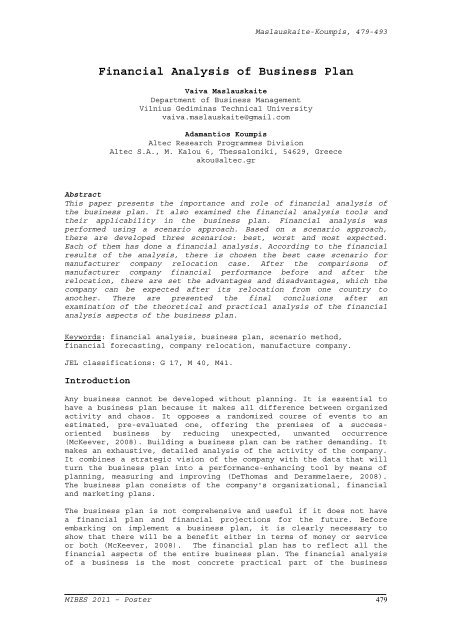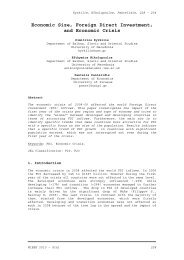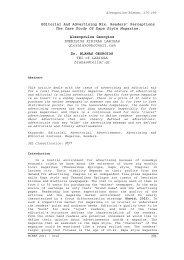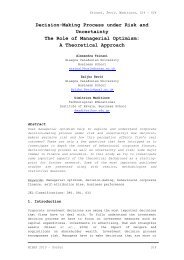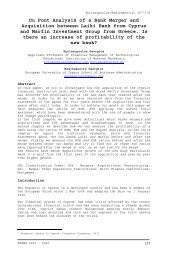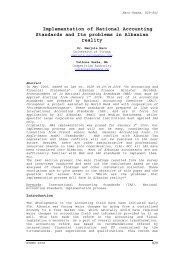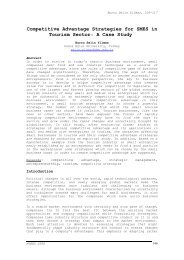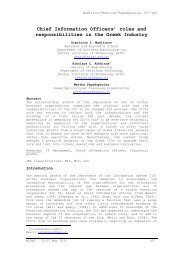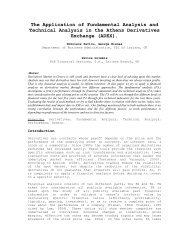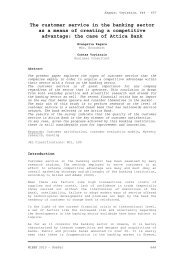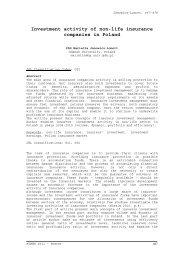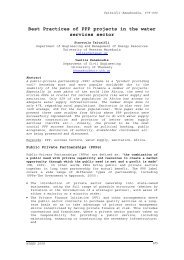Financial Analysis of Business Plan - mibes
Financial Analysis of Business Plan - mibes
Financial Analysis of Business Plan - mibes
You also want an ePaper? Increase the reach of your titles
YUMPU automatically turns print PDFs into web optimized ePapers that Google loves.
MIBES 2011 – Poster<br />
Maslauskaite-Koumpis, 479-493<br />
<strong>Financial</strong> <strong>Analysis</strong> <strong>of</strong> <strong>Business</strong> <strong>Plan</strong><br />
Vaiva Maslauskaite<br />
Department <strong>of</strong> <strong>Business</strong> Management<br />
Vilnius Gediminas Technical University<br />
vaiva.maslauskaite@gmail.com<br />
Adamantios Koumpis<br />
Altec Research Programmes Division<br />
Altec S.A., M. Kalou 6, Thessaloniki, 54629, Greece<br />
akou@altec.gr<br />
Abstract<br />
This paper presents the importance and role <strong>of</strong> financial analysis <strong>of</strong><br />
the business plan. It also examined the financial analysis tools and<br />
their applicability in the business plan. <strong>Financial</strong> analysis was<br />
performed using a scenario approach. Based on a scenario approach,<br />
there are developed three scenarios: best, worst and most expected.<br />
Each <strong>of</strong> them has done a financial analysis. According to the financial<br />
results <strong>of</strong> the analysis, there is chosen the best case scenario for<br />
manufacturer company relocation case. After the comparisons <strong>of</strong><br />
manufacturer company financial performance before and after the<br />
relocation, there are set the advantages and disadvantages, which the<br />
company can be expected after its relocation from one country to<br />
another. There are presented the final conclusions after an<br />
examination <strong>of</strong> the theoretical and practical analysis <strong>of</strong> the financial<br />
analysis aspects <strong>of</strong> the business plan.<br />
Keywords: financial analysis, business plan, scenario method,<br />
financial forecasting, company relocation, manufacture company.<br />
JEL classifications: G 17, M 40, M41.<br />
Introduction<br />
Any business cannot be developed without planning. It is essential to<br />
have a business plan because it makes all difference between organized<br />
activity and chaos. It opposes a randomized course <strong>of</strong> events to an<br />
estimated, pre-evaluated one, <strong>of</strong>fering the premises <strong>of</strong> a successoriented<br />
business by reducing unexpected, unwanted occurrence<br />
(McKeever, 2008). Building a business plan can be rather demanding. It<br />
makes an exhaustive, detailed analysis <strong>of</strong> the activity <strong>of</strong> the company.<br />
It combines a strategic vision <strong>of</strong> the company with the data that will<br />
turn the business plan into a performance-enhancing tool by means <strong>of</strong><br />
planning, measuring and improving (DeThomas and Derammelaere, 2008).<br />
The business plan consists <strong>of</strong> the company's organizational, financial<br />
and marketing plans.<br />
The business plan is not comprehensive and useful if it does not have<br />
a financial plan and financial projections for the future. Before<br />
embarking on implement a business plan, it is clearly necessary to<br />
show that there will be a benefit either in terms <strong>of</strong> money or service<br />
or both (McKeever, 2008). The financial plan has to reflect all the<br />
financial aspects <strong>of</strong> the entire business plan. The financial analysis<br />
<strong>of</strong> a business is the most concrete practical part <strong>of</strong> the business<br />
479
MIBES 2011 – Poster<br />
Maslauskaite-Koumpis, 479-493<br />
plan. <strong>Financial</strong> plan can to arouse the greatest interest from head <strong>of</strong><br />
the company or investors (Frinch, 2007). Good financial analysis<br />
requires accurate and detailed data that are collected for the case<br />
purpose on which business plan has been created.<br />
The business plan presents the case and it depends on purpose <strong>of</strong><br />
business planning. Company may need to start-up or expand its business<br />
in the new foreign or local market. If company wants to avoid<br />
unexpected problems, it has to investigate a target market. After<br />
investigation <strong>of</strong> market, company uses available data and goes deeper<br />
in case analysis and business planning (Breadley and Myers, 1996). The<br />
business plan case analysis includes different scenarios which show<br />
what financial and non-financial pr<strong>of</strong>it company can expect in the<br />
future.<br />
The basis <strong>of</strong> case scenario creation presents: “what” and “how” company<br />
performs after few years. Different scenario shows what company can<br />
expect in the best, the most expected and the worst cases. The<br />
financial analysis presents pr<strong>of</strong>itability, payback <strong>of</strong> investment and<br />
level <strong>of</strong> risk in each scenario (Palepu et al., 2004). The detailed<br />
financial analysis <strong>of</strong> business plan case scenarios protect company<br />
from unexpected expenses and help to manage its financial decisions.<br />
The financial analysis <strong>of</strong> business plan is significant topic because<br />
company before taking a decision that affects its activity does not<br />
always examine the possible opportunities, consequences and risks. The<br />
main purpose <strong>of</strong> this paper is to make the financial analysis <strong>of</strong><br />
company relocation business plan by providing to use scenario method<br />
in financial decision making.<br />
1. Literature review<br />
1.1. <strong>Business</strong> <strong>Plan</strong><br />
Every type <strong>of</strong> business necessarily requires planning. “A business plan<br />
is exactly what its name applies. It is a blue print, detailing what<br />
business are or business concept is, what is expected for the<br />
business, how management intends to get the firm to that point, and,<br />
<strong>of</strong> greatest importance, the specific reasons why it is expected to<br />
succeed” (DeThomas and Derammelaere, 2008, pg. 7).<br />
According to Finch (2007), before starting to write a business plan we<br />
decide what the plan is for and to which audience it is dedicated.<br />
This author presents six issues why business plans are made for:<br />
investment to new idea or in an existing business, buying a business,<br />
entering a joint venture, accepting tender to carry out a contract,<br />
giving a grant or a regulatory approval, helping to run own business.<br />
<strong>Business</strong> plans are made to cover the financial aspects <strong>of</strong> starting or<br />
expanding business – how much company need and how much she will be<br />
pay back (McKeever, 2008). “Preparing a business plan requires time<br />
and effort, but the task is certainly not beyond the reach <strong>of</strong> typical<br />
entrepreneur. It involves performing the same activities that<br />
successful managers perform as a standard part <strong>of</strong> managing and<br />
operating a business” (DeThomas and Derammelaere, 2008, pg. 7). It<br />
shows that every business plan has to be made responsibly with clear<br />
purpose and to be dedicated personally to entrepreneur who reads it.<br />
According to literature review and Table 1, we can come to conclusion:<br />
there are two main types <strong>of</strong> business plans and six reasons start to do<br />
480
MIBES 2011 – Poster<br />
Maslauskaite-Koumpis, 479-493<br />
it. Table 1 presents that start-up business plan is made only then we<br />
want to get an investment for new idea. When company wants to expand,<br />
it faces with some issues such as investment to existing business,<br />
buying a business, entering a joint venture and accepting to carry out<br />
a contract and wants to go on it; it needs to make a business plan as<br />
Table 1 The Types <strong>of</strong> <strong>Business</strong> <strong>Plan</strong>s and Issues for Starting to Do It<br />
(McKeever 2008; DeThomas and Derammelaere, 2008)<br />
Types<br />
Issues<br />
Investment<br />
to new idea<br />
Investment<br />
to existing<br />
business<br />
Buying a<br />
business<br />
Entering<br />
a joint<br />
venture<br />
Accepting<br />
to carry<br />
out a<br />
contract<br />
Giving<br />
a<br />
grant<br />
Helping<br />
to run<br />
on own<br />
business<br />
Start-up<br />
business + + +<br />
Expanding<br />
business + + + + + +<br />
it faces with some issues such as investment to existing business,<br />
buying a business, entering a joint venture and accepting to carry out<br />
a contract and wants to go on it; it needs to make a business plan as<br />
well. Other two issues such as giving grant and helping to run on own<br />
business is acceptable for both types <strong>of</strong> business plans. Company has<br />
to make a business plan because it works as a tool which helps to<br />
convince entrepreneurs who wants to invest and shows how decisions<br />
will be made from marketing, management and finance sides to reach<br />
result.<br />
<strong>Business</strong> plan is made from different parts and/or sections. It<br />
contains a market analysis and details <strong>of</strong> strategic marketing,<br />
management structure, personnel and finance forecasting (DeThomas and<br />
Derammelaere, 2008; McKeever, 2008; Finch, 2007). <strong>Business</strong> plan<br />
generalize all aspects and information about a company, whether it is<br />
developed or already in process. “A full analysis <strong>of</strong> the market, the<br />
management, the finances, and the product is necessary to the health<br />
<strong>of</strong> any venture, and the planning process forces you to undertake that<br />
analysis. Without it, one or another <strong>of</strong> these areas may be neglected<br />
in the whirl <strong>of</strong> day-to-day operations” (Brooks and Stevens, 1987, pg.<br />
14). As we can see, it includes the object <strong>of</strong> activity, market<br />
analysis, and specific approach to strategy <strong>of</strong> marketing, management<br />
structure, personnel and all relevant financial information <strong>of</strong> the<br />
company.<br />
According to McKeever (2008) and Frinch (2007), person or company<br />
which decided to make a business has to be well informed and<br />
experienced at this type <strong>of</strong> business which it chooses to develop. It<br />
is more important for the company which starts business but also the<br />
company which decided to expand or make big changes in her business,<br />
has to prepare a business plan as well. There are five different types<br />
<strong>of</strong> business as: retail, wholesaler, service, manufacturing and project<br />
development (McKeever, 2008, pp. 25-26).<br />
One <strong>of</strong> the types <strong>of</strong> business is manufacturing. “Manufacturers assemble<br />
components or process raw materials into products usable by consumers<br />
or other business” (McKeever, 2008, pg. 26). Manufacturing changes<br />
slowly. It takes a long time to build new facilities, install new<br />
equipment, develop new suppliers, change operating procedures, train<br />
personnel, and close or move existing facilities. “In many companies,<br />
personnel inside and outside the manufacturing function realize that<br />
manufacturing struggles to provide what the company needs to be<br />
481
MIBES 2011 – Poster<br />
Maslauskaite-Koumpis, 479-493<br />
successful. This is due to the increase in customer expectations and<br />
competitors’ capabilities and also to outdated manufacturing<br />
capabilities. Manufacturing can meet market expectations only by<br />
realigning itself, making improvements, and increasing manufacturing<br />
capabilities” (Miltenburg, 2005, pg. 2). Manufacturing companies are<br />
the most stabile ones. As it was mentioned above, to make some changes<br />
in this business is very hard but sometimes it is obligatory for<br />
better access, bigger market, lower transportation cost etc. One <strong>of</strong><br />
the reasons to make changes in this business might be moving <strong>of</strong><br />
existing facilities to another place or even another country and it<br />
might cause relocation <strong>of</strong> company. Necessity to relocate company, asks<br />
to make a relocation business plan. Relocation to new country means:<br />
new market, facilities’ transportation and plenty <strong>of</strong> other changes<br />
(Broinsma, Gorter, Nijkamp, 2000).<br />
1. 2. <strong>Financial</strong> <strong>Analysis</strong><br />
The goal <strong>of</strong> financial analysis, according to Palepu et al. (2004), is<br />
to assess the performance <strong>of</strong> a company in the context <strong>of</strong> its stated<br />
goals and strategy. There are two principal tools <strong>of</strong> financial<br />
analysis: ratio analysis and cash flow analysis. Ratio analysis<br />
involves assessing how various line items in a company’s financial<br />
statements relate to one another. Cash flow analysis allows the<br />
analyst to examine the company’s liquidity, and how the company is<br />
managing its operating, investment, and financing cash flows. “The<br />
financial analysis <strong>of</strong> an organization is <strong>of</strong> interest to parties that<br />
intend to make decisions about associating with that organization in<br />
some way, whether to invest in it, work for it, recommend it or any<br />
other possibility” (Friedlob and Schleifer, 2003). According to<br />
Helfert (2001), financial analysis is the process <strong>of</strong> determining and<br />
weighing the financial impact <strong>of</strong> business decisions. It analyses past,<br />
current and future financial situation <strong>of</strong> business. To make a good<br />
financial analysis is significant to use financial statements; the<br />
most important is cash flow and financial ratios. Palepu et al. (2004)<br />
definition <strong>of</strong> financial analysis differ from other literature sources<br />
because he divides it to three parts: accounting analysis, he calls as<br />
making <strong>of</strong> financial statements, financial analysis use cash flow and<br />
financial ratios tools and prospective analysis, he mentions as future<br />
perspectives.<br />
<strong>Business</strong> plan is made from different parts and one <strong>of</strong> them is<br />
financial plan. To write a good financial plan is recommended to use<br />
financial analysis. “Smart financial managers consider the overall<br />
effect <strong>of</strong> financing and investment decisions. This process is called<br />
financial planning and the end result is a financial plan” (Breadley<br />
and Myers, 1996, pg. 794). According to Helfert (2001), financial<br />
business plan consists <strong>of</strong> a 12-month pr<strong>of</strong>it and loss projection, a<br />
four-year pr<strong>of</strong>it and loss projection (optional), a cash flow<br />
projection, a projected balance sheet, and a break-even calculation.<br />
“A completed financial plan for large company is a substantial<br />
document. A smaller corporation’s plan would have the same elements<br />
but less detail and documentation. For the smallest, youngest<br />
business, the financial plan may be entirely in the financial<br />
manager’s head. The basic elements <strong>of</strong> the plans will be similar,<br />
however, for firms <strong>of</strong> any size” (Breadley and Myers, 1996, pg. 797).<br />
482
MIBES 2011 – Poster<br />
Maslauskaite-Koumpis, 479-493<br />
<strong>Financial</strong> plan can refer to the three pro forma 1 financial statements:<br />
balance sheet, income statement, and cash flow statement, created<br />
within a business plan (Breadley and Myers, 1996; Helfert, 2001).<br />
According to Palepu et al. (2004), the forms <strong>of</strong> pro forma statements<br />
are recommended and suggested to use prepared under GAAP 2 rules, to<br />
make sure, that it lets to avoid misunderstandings with investors,<br />
creditors etc. According to Breadley and Myers (1996), pro forma<br />
statements present the financial goals <strong>of</strong> company and it may not be<br />
strictly unbiased forecasts. The earnings in the financial plan may be<br />
somewhere between an honest forecast and earnings that managers hope<br />
to achieve.<br />
According to literature review <strong>of</strong> Breadley and Myers (1996), Helfert<br />
(2001), Palepu et al. (2004), every good financial plan must include<br />
not only three main financial statements: balance sheet, cash flow and<br />
income statements, all <strong>of</strong> them are pro forma ones, but also there has<br />
to be added operating forecast, break-even analysis and financial<br />
ratios which depends on goal <strong>of</strong> business plan. Also, it might include<br />
sections <strong>of</strong> request for start-up funds, financial history and<br />
analysis, financial current position, if it is necessary.<br />
According to literature review <strong>of</strong> Breadley and Myers (1996),<br />
Helfert(2001), Palepu et al. (2004) authors, cash-flow projections,<br />
income statements, and pro forma balance sheets suppose to be created<br />
for at least three years into the future, and sometimes five.<br />
<strong>Financial</strong> projections should extend far enough into the future to the<br />
point where business has achieved stable operations. If possible, it<br />
is useful to include best case, expected case, and worse case<br />
scenarios with financials. It will allow to potential investors and<br />
loan <strong>of</strong>ficers to explore the upside potential and downside risks <strong>of</strong><br />
business venture.<br />
Evaluation <strong>of</strong> financial plan pr<strong>of</strong>itability, payback, and return on<br />
investment requires calculating investment financial ratios and<br />
analyzing it. “Simplistic methods <strong>of</strong> financial analysis, which are<br />
merely rules <strong>of</strong> thumb that intuitively grapple with the trade-<strong>of</strong>f<br />
between investment and operating cash flows. They are the payback and<br />
the simple rate <strong>of</strong> return, both <strong>of</strong> which are still used in practice<br />
occasionally despite their demonstrable shortcomings” (Helfert, 2001,<br />
pg. 232).<br />
Payback. “The playback period for a project is simply the number <strong>of</strong><br />
the year it takes to recover the initial cash outlay on a project”<br />
(Weston, 1992, pg. 27). Using the data from our simplified example,<br />
the calculation is straightforward:<br />
Net investment<br />
Payback =<br />
Average annual operating cash flow<br />
The result is the number <strong>of</strong> years required for the original outlay to<br />
be repaid; answering the question, “How long will it be until I get my<br />
money back?” It is a rough test <strong>of</strong> whether the amount <strong>of</strong> the<br />
investment will be recovered within its economic life span.<br />
1 Pro forma statements are projected financial statements embodying a set <strong>of</strong> assumptions<br />
about a company’s future performance and funding requirements.<br />
2 GAAP – Generally Accepted Accounting Principles.<br />
( 1);<br />
483
MIBES 2011 – Poster<br />
Maslauskaite-Koumpis, 479-493<br />
Return on investment (ROI). According to Helfert (2001), it states the<br />
desirability <strong>of</strong> an investment in terms <strong>of</strong> a percentage return on the<br />
original outlay. A performance measure used to evaluate the efficiency<br />
<strong>of</strong> an investment or to compare the efficiency <strong>of</strong> a number <strong>of</strong> different<br />
investments. To calculate ROI, the benefit (return) <strong>of</strong> an investment<br />
is divided by the cost <strong>of</strong> the investment; the result is expressed as a<br />
percentage or a ratio.<br />
Average annual operating cash flow<br />
ROI =<br />
Net investment<br />
At the above formula (2) “gains from investment”, refers to the<br />
proceeds obtained from selling the investment <strong>of</strong> interest. That is, if<br />
an investment does not have a positive ROI, or if there are other<br />
opportunities with a higher ROI, then the investment should be not be<br />
undertaken.<br />
This is one <strong>of</strong> possible business investment analysis. It is as the<br />
process <strong>of</strong> weighing the economic trade-<strong>of</strong>f between current money value<br />
outlays and future net cash flow benefits that are expected to be<br />
obtained over a relevant period <strong>of</strong> time (Helfert, 2001).<br />
1. 3. Scenario<br />
The origins <strong>of</strong> scenario show how definition and understanding <strong>of</strong><br />
scenario meaning was changing. “The concept <strong>of</strong> using alternative<br />
scenarios for institutional planning was popularized by Kahn and<br />
Wiener in writings about “surprise-free” futures. It had been Herman<br />
Kahn who introduced the word “scenario” into the planner’s vocabulary<br />
while at RAND Corporation in the 1950s. The term was used in<br />
connection with military and strategic studies conducted by RAND for<br />
the government; it appeared in the “open” literature in the text <strong>of</strong><br />
the Kahn and Wiener book “The Year 2000” in the late 1960s. In that<br />
publication, “scenarios” were defined as hypothetical sequences <strong>of</strong><br />
events constructed for the purpose <strong>of</strong> focusing attention on causal<br />
processes and decision points” (Zentner, 1982, pg. 14).<br />
According to Chermack (2002), there are a large number <strong>of</strong> different<br />
and at times conflicting definitions, characteristics, principles and<br />
methodological ideas about scenarios. “The process <strong>of</strong> scenario<br />
planning is relatively young, and many variations have been developed.<br />
This variety <strong>of</strong> approaches can also be found in the available<br />
definitions and espoused dependent or outcome variables <strong>of</strong> scenario<br />
planning” (Chermack, 2002) (see Appendix).<br />
According to Chermack (2002), all gathered available definitions <strong>of</strong><br />
scenario planning summarize, analyze and collapse it into “four major<br />
outcome categories <strong>of</strong> scenario planning:<br />
changed thinking,<br />
informed narratives or stories about possible or plausible<br />
futures,<br />
improved decision making about the future,<br />
enhanced human and organization learning and imagination”<br />
(Chermack, 2002, pg. 373).<br />
Zentner article which was written in 1982 and the literature review<br />
made by Chermack in 2002 show that scenario planning is about possible<br />
( 2);<br />
484
MIBES 2011 – Poster<br />
Maslauskaite-Koumpis, 479-493<br />
future decisions, forecasting, human and organization behaving in<br />
planning processes. It is not enough to have scenario definition. The<br />
scenario as a tool will work properly if we use methods <strong>of</strong> it.<br />
The terms planning, thinking, forecasting, analysis and learning are<br />
commonly attached to the scenario conception. It depends on several<br />
overlapping camps <strong>of</strong> opinion, testimony. The literature reveals a<br />
large number <strong>of</strong> different and at times conflicting definitions,<br />
characteristics, principles and methodological ideas about scenarios<br />
(Bradfield et al., 2005).<br />
2. METHODOLOGY<br />
According to the purpose <strong>of</strong> this paper, there is used one <strong>of</strong> scenario<br />
methods. “The Art <strong>of</strong> Long View” method is a checklist which is used as<br />
the basis for scenario development and it has eight steps (Ringland,<br />
1998) “The Art <strong>of</strong> Long View” method will be adapted to the company<br />
relocation case.<br />
“The Art <strong>of</strong> Long View” Method and Company Relocation Case<br />
The company which we will talk about is situated in Estonia and<br />
decides to move to Lithuania. “Astran” Ltd. is producing EURO pallets<br />
and has the agreement with Icelandic company “Adakarisson” Ltd.<br />
According to agreement, “Astran” Ltd. has to delivery EURO pallets<br />
elements every month to Klaipeda seaport. Company wants to reduce<br />
transportation cost and <strong>of</strong> it she decided to relocate. We will use<br />
“The Art <strong>of</strong> Long View” method to develop scenarios. Created Scenarios<br />
will show what “Astran” Ltd. may expect in the future if she accept<br />
the decision to relocate.<br />
Step One: Identify Focal Issue or Decision. “When developing<br />
scenarios, it’s good idea to begin “from the inside out” rather than<br />
“from inside in”. This is, begin with specific decision or issue, then<br />
build out towards the environment [...] How can you be sure that the<br />
differences that distinguish your scenario will really make a<br />
difference to your business or your life? The best way is to begin<br />
with important decisions that have to be made and the mind-set <strong>of</strong> the<br />
management making them.” (Ringland, 1998, pp. 228-229).<br />
The focal issue <strong>of</strong> the “Astran” Ltd. was big cost <strong>of</strong> transportation<br />
and company decided to take decision to relocate.<br />
Step Two: Key Forces in the Local Environment. This step shows which<br />
key factors are influencing the success or failure <strong>of</strong> the decision. It<br />
includes facts about customers, suppliers etc. (Ringland, 1998). Key<br />
forces which have influence on company are:<br />
Sales to Iceland. The main costumer <strong>of</strong> “Astran” Ltd. is<br />
Icelandic company “Adakrisson” Ltd.;<br />
Transportation costs. Company has big costs <strong>of</strong> transportation<br />
because the main wood supplier is from Belorussia and “Astran”<br />
Ltd. has to deliver EURO pallets to Klaipeda seaport which is<br />
far from Estonia as well.<br />
Taxes. The taxes are high in Estonia. Company is paying Income<br />
tax (21%), Guaranty fund (1,4%) and Social tax (33%).<br />
Step Three: Driving Forces. “Once the key factors have been listed,<br />
the third step involves listing driving forces in the macroenvironment<br />
that influence the key factors identified earlier. In<br />
485
MIBES 2011 – Poster<br />
Maslauskaite-Koumpis, 479-493<br />
addition to a checklist <strong>of</strong> social, economic, political, and<br />
technological forces [...] this is the most research-intensive step in<br />
the process” (Ringland, 1998, pp. 229-230). There will be identified<br />
main driving forces <strong>of</strong> “Astran” Ltd. relocation to Lithuania: Social<br />
force, Lithuania geographical location: The distance between Lithuania<br />
and Belorussia is 500 km. and Klaipeda seaport is located in<br />
Lithuania. Economic force, unemployment ratio is high 17, 2% (data:<br />
2011 I QR. (Statistics Lithuania)). It is easier to find labour.<br />
Political force, taxes are smaller in Lithuania: Income tax (15%),<br />
Guaranty fund (0,01%) and Social tax (30,98%). Technological force is<br />
not very important because “Astran” Ltd. will move facilities from<br />
Estonia to Lithuania.<br />
Step Four: Rank by Importance and Uncertainty. The ranking <strong>of</strong> key<br />
factors and driving forces on the basis <strong>of</strong> two criteria: first, the<br />
degree <strong>of</strong> importance for the success <strong>of</strong> the focal issue or decision<br />
identified in step one: second, the degree <strong>of</strong> uncertainty surrounding<br />
those factors or trends. The point is to identify the two or three<br />
factors or trends that are most important and most uncertain. Scenario<br />
cannot differ over predetermined elements because predetermined<br />
elements are bound to be the same in all scenarios” (Ringland, 1998,<br />
pg. 230). The main issue <strong>of</strong> company relocation is sales to Icelandic<br />
company “Adakrisson” Ltd. Following, we have other two: transportation<br />
distances and taxes (Table 2).<br />
Table 2 Key Factors and Driving Force <strong>of</strong> Relocation<br />
Issue Estonia Lithuania<br />
Sales to Iceland (unit) 56 000 56 000<br />
Transportation distances (km)<br />
Taxes (%)<br />
To Belorussia 700 500<br />
To Klaipeda seaport 550 65<br />
Income tax 21% 15%<br />
Guaranty fund 1,4% 0,01%<br />
Social tax 33% 30,98%<br />
According to Table 2, Lithuania has better location for logistics. It<br />
is closer to Belorussia and Klaipeda seaport is very near. Taxes in<br />
Estonia are higher than in Lithuania. This data shows that relocation<br />
<strong>of</strong> company is good and pr<strong>of</strong>itable decision because the quantity <strong>of</strong><br />
produced EURO pallets is the same.<br />
Step Five: Selecting the Scenario Logics. “The results <strong>of</strong> this ranking<br />
exercise are, in effect, the axes along which the eventual scenarios<br />
will differ. Determining these axes is among the most important steps<br />
in the entire scenario –generating process. The goal is to end up with<br />
just a few scenarios whose differences make a difference to decisionmakers”(Ringland,<br />
1998, pg. 230). As it was mentioned above, the main<br />
reason <strong>of</strong> “Astran” company relocation is sales to “Adakrisson” Ltd.<br />
According it, we will make three different scenarios:<br />
Scenario 1 – the best case – All EURO pallets are sold to Adakrisson”<br />
Ltd.<br />
486
MIBES 2011 – Poster<br />
Maslauskaite-Koumpis, 479-493<br />
Scenario 2 – the base case – “Astran” Ltd. sells the same quantity <strong>of</strong><br />
EURO pallets to “Adakrisson” Ltd. and other customers, as it does in<br />
Estonia.<br />
Scenario 3 – the worst case – All EURO pallets are sold to other<br />
customers.<br />
Step Six: Fleshing Out the Scenario. The most important forces<br />
determine the logics that distinguish the scenarios, fleshing out the<br />
skeletal scenarios can be accomplished by returning to the list <strong>of</strong> key<br />
factors and trends (Table 5) identified in steps one two and three.<br />
Each key factor and trend should be given some attention in each<br />
scenario” (Ringland, 1998, pg. 232). According to Step Six, we will<br />
make mini review about each <strong>of</strong> scenario.<br />
Scenario 1: Sales to Icelandic company. All the EURO pallets which are<br />
produced by company are sold to “Adakrisson” Ltd. The quantity <strong>of</strong><br />
produced EURO pallets is 66667 units per month. The cost <strong>of</strong> one pallet<br />
is 4,5 €, because “Astran” Ltd. sells EURO pallets in elements, it<br />
means that pallets are not full complected; Transportation. “Astran”<br />
Ltd. organises two trips one from Lithuania to Belorussia and another<br />
one between two Lithuanian towns: Plunge and Klaipeda. Taxes. The<br />
amount <strong>of</strong> money which is paid for payroll taxes will change because<br />
“Astran” Ltd. do not need to have so many factory workers and<br />
marketing employees. Income tax depends on Income from operations<br />
amount.<br />
Scenario 2: Sales to “Adakrisson” Ltd. Company sells 56 000 unit <strong>of</strong><br />
EURO pallets to Icelandic company for 4,5 € and 10 667 units <strong>of</strong> full<br />
complected pallets to other customers for 6 €. Transportation.<br />
Company organises two trips one from Lithuania to Belorussia and<br />
another one between Lithuanian towns: Plunge and Klaipeda. Taxes.<br />
Income tax depends on Income from operations amount and amount <strong>of</strong><br />
Payroll tax depends on quantity <strong>of</strong> employees at company in Scenario 2<br />
case.<br />
Scenario 3: No sales to Iceland. The EURO pallets is sold to other<br />
customers for 6€ per each. Transportation. Company organises only one<br />
trip from Lithuania to Belorussia and other trip to Klaipeda seaport<br />
is cancelled. Taxes. Company needs to hire more employees for EURO<br />
pallets collecting and Marketing sector expands because company has to<br />
find new customers to sell EURO pallets and it will has influence on<br />
Payroll tax. Income tax depends on Income from operations amount.<br />
Step Seven: Implementation. “Once the scenarios have been developed in<br />
some details, then it is time to return on focal issue or decision<br />
identified in step one to rehearse the future. How does the decision<br />
look in each scenario?” (Ringland, 1998, pg. 232).<br />
Step Eight: Selection <strong>of</strong> Leading Indicators and Signposts“. It is<br />
important to know as soon as possible which <strong>of</strong> the several scenarios<br />
is closest to course <strong>of</strong> history as it actually unfolds” (Ringland,<br />
1998, pg. 232). The different scenarios have been flashed out and<br />
their implications for the decision determined, then it is worth to<br />
analyse it more. If indicators are selected carefully and<br />
imaginatively, the company will know what the future holds for and how<br />
that future is likely to affect strategies and decisions. (Ringland,<br />
1998).<br />
The Step Seven and Eight will be revealed in Application part. It<br />
presents company activities in Estonia, descriptions and financial<br />
487
MIBES 2011 – Poster<br />
Maslauskaite-Koumpis, 479-493<br />
analysis <strong>of</strong> each scenario in relocation to Lithuania case and helps to<br />
find out the pr<strong>of</strong>itability which company can expect if she decides to<br />
relocate.<br />
3. APPLICATION<br />
This unit presents “Astran” Ltd. company and its activities before and<br />
after relocation. This company was working in Estonia before it took<br />
the decision to relocate to Lithuania. We will review sales,<br />
transportation and financial statements forecasting.<br />
Astran Ltd. produces EURO pallets and wood products. The main customer<br />
<strong>of</strong> Astran Ltd. is Icelandic company - Adakrisson Ltd. The sales to<br />
main costumer is 56 000 EURO pallets in elements and 10 6667 full<br />
complected EURO pallets to other customers. The company has 34<br />
employees. Every month it spends 39944,26 € for salaries and Payroll<br />
tax takes 10223,83 € <strong>of</strong> this amount. Astran Ltd. organises two trips:<br />
to export wood from Belorussia (Trip 1) and to deliver pallets to<br />
Klaipeda seaport (Trip 2), every month it costs 89 004 €. Net pr<strong>of</strong>it<br />
<strong>of</strong> company is 44 162 € after one month and 913 119 € <strong>of</strong> all 2010 year.<br />
The only asset which company has is facilities, other things are<br />
rented.<br />
The Art <strong>of</strong> View method is adapted to Astran Ltd. relocation case.<br />
According to it, the main focal issue is Astran Ltd. relocation from<br />
Estonia to Lithuania. The key forces which have influence for company<br />
relocation are sales to Icelandic company Adakrisson Ltd., high<br />
transportation cost and lower taxes in Lithuania. According to this<br />
scenario method, it was created three scenarios: the best case – All<br />
EURO pallets are sold to Adakrisson Ltd.; the base case – Astran Ltd.<br />
sells the same quantity <strong>of</strong> EURO pallets to Adakrisson Ltd. and other<br />
customers, as it does in Estonia; the worst case – All EURO pallets<br />
are sold to other customers.<br />
The main issue why “Astran” Ltd. decided to relocate was partnership<br />
agreement with “Adakrisson” Ltd. According to this agreement, company<br />
has to deliver EURO pallets to Klaipeda seaport. “Astran” Ltd. decided<br />
to reduce expenses because it may help to get more pr<strong>of</strong>it from this<br />
agreement. The main costs which company can reduce are transportation<br />
ones. It took a decision to relocate company to Lithuania because this<br />
country is closer to Belorussia than Estonia and Klaipeda seaport is<br />
located in Lithuania. As it was mentioned before, company has only<br />
facilities and other things are rented. “Astran” Ltd. has to move its<br />
facilities from Estonia to Lithuania. The relocation <strong>of</strong> “Astran” Ltd.<br />
facilities from Estonia to Lithuania have cost 11 955 € and takes five<br />
days.<br />
Following company relocation case, this section presents three<br />
different scenarios: the best case, the base case and the worst case.<br />
These scenarios are based on company sales to Icelandic company<br />
“Adakrisson” Ltd. and present changes <strong>of</strong> salary, transportation cost<br />
and show financial forecasting in every case <strong>of</strong> 5 five years.<br />
Scenario 1 (The best case). “Astran” Ltd. sells all production<br />
(66 667 units <strong>of</strong> EURO pallets) to “Adakrisson” Ltd. Company has<br />
25 employees and has 26 482 € expenses <strong>of</strong> salary. “Astran” Ltd.<br />
organises Trip 1 and Trip 2, transportation cost 61 929 € per<br />
month. The company gets 52 676 € Net pr<strong>of</strong>it after one month. The<br />
488
MIBES 2011 – Poster<br />
Maslauskaite-Koumpis, 479-493<br />
break-event point is 20 796 units <strong>of</strong> EURO pallets. The low-risk<br />
scenario.<br />
Scenario 2 (The base case). “Astran” Ltd. sells 56 000 units <strong>of</strong><br />
EURO pallets to Adakrisson Ltd. and 10 667 units to other<br />
customers. Company has 28 employees and has 28 275 € expenses <strong>of</strong><br />
salary. “Astran” Ltd. organises Trip 1 and Trip 2,<br />
transportation cost 61 267 € per month. The Company gets 61 065<br />
€ Net pr<strong>of</strong>it after one month. The break-event point is 14 014<br />
units <strong>of</strong> EURO pallets. The middle-risk scenario.<br />
Scenario 3 (The worst case). “Astran” Ltd. sells all EURO<br />
pallets to other customers. Company has 30 employees and has 29<br />
380 € expenses <strong>of</strong> salary. “Astran” Ltd. organises only Trip 1,<br />
transportation cost 57 809 € per month. The Company gets 158 338<br />
€ Net pr<strong>of</strong>it after one month. The break-event point is 10 568<br />
units <strong>of</strong> EURO pallets. The high-risk scenario.<br />
Scenario 2 is the most suitable because it has middle-risk, “Astran”<br />
Ltd. sells pallets to “Adakrisson” Ltd. and to other customers,<br />
organise both trips, financial data shows pr<strong>of</strong>it and is the most<br />
similar to the company‘s activities in Estonia before relocation to<br />
Lithuania.<br />
There are calculated Payback and Return on Investment financial<br />
ratios. Payback ratio shows “Astran” Ltd. relocation buy <strong>of</strong>f very<br />
fast: Scenario 1 needs 11 days, Scenario 2 – 8 days and Scenario 3 – 4<br />
days. ROI ratio calculations present that investment to relocation buy<br />
<strong>of</strong>f 36 times or 3 615% in the best case scenario, 45 times or 4 598%<br />
in the base case scenario and 105 times and 10 523% in the worst case<br />
scenario.<br />
According to analysis <strong>of</strong> key factors, we can calculate the amount <strong>of</strong><br />
money which “Astran” Ltd. saves per one month <strong>of</strong> company relocation<br />
from Estonia to Lithuania (Table 3).<br />
Table 3 Saved Money <strong>of</strong> “Astran” Ltd. after One Month Relocation<br />
Key factor<br />
Transportation<br />
Taxes<br />
Cost in<br />
Estonia(€)<br />
Cost in<br />
Lithuania (€)<br />
Saved amount<br />
<strong>of</strong> money (€)<br />
Trip 1 68 235,31 57 809,80 10 425,51<br />
Trip 2 20 768,91 3 457,67 17 311,34<br />
Payroll tax 10 223,83 6 277,17 3 946,66<br />
Income tax 14 475,08 12 201,96 2 273,12<br />
Total: 33 956,53<br />
Table 3 presents amount <strong>of</strong> money which “Astran” Ltd. saves <strong>of</strong><br />
relocation from Estonia to Lithuania after one month activities. It is<br />
33 956 €. If we compare this money with company relocation cost (11<br />
955 €) we will become to conclusion that it is really pr<strong>of</strong>itable and<br />
worth to relocate “Astran” Ltd. company.<br />
Advantages <strong>of</strong> Company Relocation from Estonia to Lithuania:<br />
489
MIBES 2011 – Poster<br />
Maslauskaite-Koumpis, 479-493<br />
1. Shorter distances. Transportation is cheaper and faster because<br />
the distance between Lithuania and Belorussia is shorter than<br />
between Estonia and Belorussia;<br />
2. Lower taxes. Income and Payroll taxes are lower in Lithuania<br />
than in Estonia;<br />
3. Klaipeda seaport is located in Lithuania. This advantages lets<br />
to reduce transportation cost <strong>of</strong> Trip 1;<br />
4. Smaller number <strong>of</strong> employees. Shorter distances let to hire<br />
smaller number <strong>of</strong> drivers and save money.<br />
5. Lithuania is closer to Eastern, Western and Southern Europe<br />
markets than Estonia. Better connection with Europe, it is<br />
easier to find new costumers.<br />
Disadvantages <strong>of</strong> Company Relocation from Estonia to Lithuania:<br />
1. Relocation process and cost. Relocation cost money and time.<br />
Company has to stop working while all facilities will be<br />
relocated from one country to another.<br />
2. Far from Northern Europe market. “Astran” Ltd. may lose<br />
customers from this part <strong>of</strong> Europe;<br />
3. Recruitment. “Astran” Ltd. has to find experienced and trustful<br />
employees in Lithuania and it may cost extra expenses;<br />
4. Entering to Lithuania EURO pallets market. This market may have<br />
strong competitors and can be very difficult to gain a foothold<br />
in this market. The entering to new market asks researches, time<br />
and additional costs.<br />
The advantages and disadvantages <strong>of</strong> “Astran” Ltd. relocation from<br />
Estonia to Lithuania present that there are more advantages than<br />
disadvantages. Company relocation to Lithuania is good decision<br />
because “Astran” Ltd. earns more money, saves money <strong>of</strong> transportation<br />
and taxes, and it is closer to other customers. Disadvantages are<br />
based <strong>of</strong> relocation process and cost, recruitment and “Astran” Ltd.<br />
may lose customers with who was working till company relocation. As<br />
result, “Astran” Ltd. relocation from Estonia to Lithuania is wise and<br />
pr<strong>of</strong>itable decision.<br />
CONCLUSIONS<br />
The main purpose <strong>of</strong> this paper is to make the financial analysis <strong>of</strong><br />
company relocation business plan by providing to use scenario method<br />
in financial decision making. It is achieved, adapted and examined<br />
from literature and application point <strong>of</strong> view.<br />
<strong>Business</strong> plan is necessary in business planning and developing.<br />
<strong>Business</strong> plan presents a business idea, how it will be reached and<br />
what a pr<strong>of</strong>it will be got from it. It contains a market analysis and<br />
details <strong>of</strong> strategic marketing, management structure, personnel and<br />
finance forecasting. There are two types <strong>of</strong> business plans: start-up<br />
and company expanding.<br />
Type <strong>of</strong> business is very important in business plan preparing process.<br />
There are five different types <strong>of</strong> business as: retail, wholesaler,<br />
service, manufacturing and project development. Manufacturing<br />
companies are the most stabile ones and to make changes in this<br />
business is hard but sometimes it is obligatory for better access,<br />
bigger market, lower transportation cost. <strong>Business</strong> plan for<br />
manufacturing company has to be prepared carefully and based on<br />
reliable estimations.<br />
490
MIBES 2011 – Poster<br />
Maslauskaite-Koumpis, 479-493<br />
<strong>Business</strong> plan is made from different sections and one <strong>of</strong> them is<br />
financial plan. <strong>Financial</strong> plan includes financial analysis. <strong>Financial</strong><br />
analysis is the process <strong>of</strong> determining and weighing the financial<br />
impact <strong>of</strong> business decisions. It analyses past, current and future<br />
financial situation <strong>of</strong> business. <strong>Financial</strong> analysis consists <strong>of</strong><br />
financial statements and ratios.<br />
<strong>Financial</strong> plan includes three financial statements: balance sheet,<br />
cash flow and income statements, all <strong>of</strong> them are pro forma<br />
(forecasting) and there can be added operating forecast, break-even<br />
analysis and financial ratios. The most important is cash flow<br />
statement and financial ratios.<br />
The conception <strong>of</strong> scenario is variable. The terms planning, thinking,<br />
forecasting, analysis and learning are commonly attached to the<br />
scenario conception. <strong>Analysis</strong> <strong>of</strong> scenario definition presents four<br />
major outcome categories: changed thinking, informed narratives or<br />
stories about possible or plausible futures, improved decision making<br />
about the future, enhanced human and organization learning and<br />
imagination.<br />
“The Art <strong>of</strong> View” method is adapted to “Astran” Ltd. relocation case.<br />
According to it, the main focal issue is “Astran” Ltd. relocation from<br />
Estonia to Lithuania. The key forces which have influence for company<br />
relocation are sales to Icelandic company “Adakrisson” Ltd., high<br />
transportation cost and lower taxes in Lithuania. According to this<br />
scenario method, it was created three scenarios: the best case – All<br />
EURO pallets are sold to “Adakrisson” Ltd.; the base case – “Astran”<br />
Ltd. sells the same quantity <strong>of</strong> EURO pallets to “Adakrisson” Ltd. and<br />
other customers, as it does in Estonia; the worst case – All EURO<br />
pallets are sold to other customers.<br />
There are calculated Payback and Return on Investment financial<br />
ratios. Payback ratio shows “Astran” Ltd. relocation buy <strong>of</strong>f very<br />
fast: Scenario 1 needs 11 days, Scenario 2 – 8 days and Scenario 3 – 4<br />
days. ROI ratio calculations present that investment to relocation buy<br />
<strong>of</strong>f 36 times in the best case scenario, 45 times in the base case<br />
scenario and 105 times in the worst case scenario.<br />
The expected case scenario is the most suitable because it has middlerisk,<br />
“Astran” Ltd. sells pallets to “Adakrisson” Ltd. and to other<br />
customers, organise both trips, and financial data shows pr<strong>of</strong>it and is<br />
the most similar to the company’s activities in Estonia before<br />
relocation to Lithuania.<br />
The advantages <strong>of</strong> “Astran” Ltd. relocation are shorter distances,<br />
lower taxes, Klaipeda seaport is situated in Lithuania, smaller number<br />
<strong>of</strong> employees and Lithuania is closer to Eastern, Western and Southern<br />
Europe markets than Estonia.<br />
The disadvantages <strong>of</strong> “Astran” Ltd. relocation are relocation process<br />
and cost, far from Northern Europe market, recruitment and Lithuanian<br />
EURO pallets market.<br />
Company that carries out <strong>of</strong> detailed and reliable financial analysis<br />
makes financial decisions that will bring future pr<strong>of</strong>its. Scenario<br />
method is one <strong>of</strong> the tools which helps to do it right and correct.<br />
491
References<br />
MIBES 2011 – Poster<br />
Maslauskaite-Koumpis, 479-493<br />
1. Bradfield, R., Wright, G., Burt, G., Cairns, G., Van Der<br />
Heijden, K. (2005), “The origins and evolution <strong>of</strong> scenario<br />
techniques in long range business planning” , Futures 37 795-<br />
812, 2005;<br />
2. Breadley, A. R. and Myers, S. C. (1996), “Principles <strong>of</strong><br />
Corporate Finance” Fifth Edition, Donnelley R. R. and Sons<br />
Company, The USA, 1996;<br />
3. Brooks, J. K. and Stevens B. A. (1987), “How to Write a<br />
Successful <strong>Business</strong> <strong>Plan</strong>”, The USA, 1987;<br />
4. Bruinsma ,F., Gorter, C., Nijkamp, P. (2000), “Multimodal<br />
infrastructure, transport networks and the international<br />
relocation on firms”, Transportation <strong>Plan</strong>ning and Technol., Vol.<br />
23, pp. 259-281, Free University <strong>of</strong> Amsterdam, 2000;<br />
5. Charmack, T.J and Lynham, S. A. (2002), “Definitions and Outcome<br />
Variables <strong>of</strong> Scenario <strong>Plan</strong>ning”, Human Resource Development<br />
Review 2002 1: 366;<br />
Online: http://hrd.sagepub.com/content/1/3/366<br />
6. DeThomas, A. and Derammelaere, S. (2008), “Writing a Convincing<br />
<strong>Business</strong> <strong>Plan</strong>” Third Edition, Barron’s Educational Series press,<br />
The USA, 2008;<br />
7. Dul, J. and Hak, T. (2008), “Case Study Methodology in <strong>Business</strong><br />
research” First Edition, Charon Tec Ltd., Great Britain, 2008;<br />
8. Eisert, T. & Kremar, H. (1996), SEDAS-EDI: The EDI Project for<br />
the German Retail Industry, Proceedings <strong>of</strong> The Ninth<br />
International EDI-IOS Conference, Bled, Slovenia, June 10-12,<br />
257-290;<br />
9. Finch, B. (2007), “How to Write a <strong>Business</strong> <strong>Plan</strong>” Second Edition,<br />
MPG Books Ltd press, Great Britain, 2007;<br />
10. Friedlob, G.T., Schleifer, L. L. F. (2003), “Essentials <strong>of</strong><br />
<strong>Financial</strong> <strong>Analysis</strong>”, The USA, 2003;<br />
11. Helfert, E. A. (2001), “<strong>Financial</strong> <strong>Analysis</strong> Tools and Techniques:<br />
a Guide for Managers”, The USA, 2001;<br />
12. Klein, H.K. & Myers, M.D. (1999), A set <strong>of</strong> principles for<br />
conducting and evaluating interpretive field studies in<br />
information systems, MIS Quarterly, 23(1), 67-89;<br />
13. Martelli, A., (2001), “Scenario building and scenario planning:<br />
state <strong>of</strong> the art and prospects <strong>of</strong> evolution“, Futures Research<br />
Quarterly Summer, 2001.<br />
14. McKeever, M. (2007), “How to write a <strong>Business</strong> <strong>Plan</strong>” Ninth<br />
Edition, Consolidated Printers, Inc., The USA, 2007;<br />
15. Miles, M.B. & Huberman, A.M. (1994), “Qualitative Data<br />
<strong>Analysis</strong>”, 2nd edition, Sage Publications, London;<br />
16. Miltenburg J. (2005), “Manufacturing strategy: how to formulate<br />
and implement a wining plan” Second Edition, Kraus Productivity<br />
Organization press, USA, 2005;<br />
17. Palepu, K. G., Healy, P.M, Bernard, V. L. (2004),“<strong>Business</strong><br />
<strong>Analysis</strong> & Valuation: Using <strong>Financial</strong> Statements” Third<br />
Edition, Mason, Ohio, 2004;<br />
18. Ringland, G. (1998), “Scenario planning: Managing for the<br />
Future”, Bookcraft (Bath) Ltd., Great Britain, 1998;<br />
19. Stoner, G. and Holland, J. (2008), “The Real Life Guide to<br />
Accounting research” in Chapter 3: “Using case study in Finance<br />
Research”, Hungary, 2008.<br />
20. Walsham G. (1993), “Interpreting Information Systems in<br />
Organisations”, John Wiley, Chichester;<br />
492
MIBES 2011 – Poster<br />
Maslauskaite-Koumpis, 479-493<br />
21. Weston, C. (1992), “<strong>Financial</strong> Theory and Corporate Policy” Third<br />
Edition, Addison-Wesley Publishing Company, Inc., The USA, 1992;<br />
22. Zentner, R. D. (1982), “Scenarios, Past, Present and Future”,<br />
Long Range <strong>Plan</strong>ning, Vol. 15, No. 3, pp. 12 to 20, 1982;<br />
Appendix Definitions and Dependent Variable <strong>of</strong> Scenario (Chermack,<br />
2002, p.p. 370-372)<br />
Author<br />
(Year)<br />
Definition Dependent variable<br />
Porter “An internally consistent view <strong>of</strong> what the future A view <strong>of</strong> one<br />
(1985) might turn out to be—not a forecast, but one<br />
possible future<br />
possible future outcome”<br />
outcome<br />
Schwartz “A tool for ordering one’s perceptions about<br />
Ordered perceptions<br />
(1991) alternative future environments in which one’s<br />
about alternative<br />
decisions might be played out”<br />
future decisionmaking<br />
environments<br />
Simpson “The process <strong>of</strong> constructing alternate futures <strong>of</strong> a Constructed alternate<br />
(1992) business’ external environment”<br />
futures<br />
Bloom & “A description <strong>of</strong> a possible or probable future“ A described possible<br />
Menefee<br />
(1994)<br />
or probable future<br />
Collyns<br />
(1994)<br />
“An imaginative leap into the future” An imagined future<br />
Thomas “Scenario planning is inherently a learning process Challenged<br />
(1994) that challenges the comfortable conventional wisdoms comfortable<br />
<strong>of</strong> the organization by focusing attention on how the conventional wisdoms<br />
future may be different from the present”<br />
about the future<br />
Shoemaker “A disciplined methodology for imagining possible Imagined possible<br />
(1995) futures in which organizational decisions may be decision-making<br />
played out”<br />
futures<br />
Van der 1. External scenarios are “internally consistent and Descriptions <strong>of</strong><br />
Heijden challenging descriptions <strong>of</strong> possible futures”<br />
possible futures<br />
(1997) 2. An internal scenario is “a causal line <strong>of</strong><br />
Explicit cognitive<br />
argument, linking an action option with a goal” or<br />
“one path through a person’s cognitive map”<br />
maps<br />
De Geus “Tools for foresight-discussions and documents whose Changed mind-sets<br />
(1997) purpose is not a prediction or a plan, but a change<br />
in the mindset <strong>of</strong> the people who use them”<br />
Ringland “That part <strong>of</strong> strategic planning which relates to Managed future<br />
(1998) the tools and technologies for managing the<br />
uncertainties <strong>of</strong> the future”<br />
uncertainties<br />
“Scenario planning is one <strong>of</strong> a number <strong>of</strong> fore<br />
Human imagination and<br />
Bawden sighting techniques used in the strategic<br />
learning made<br />
(1998) development <strong>of</strong> organizations, which exploit the<br />
remarkable capacity <strong>of</strong> humans to both imagine and to<br />
learn from what is imagined”<br />
explicit<br />
Fahey & “Scenarios are descriptive narratives <strong>of</strong> plausible Plausible alternative<br />
Randall alternative projections <strong>of</strong> a specific part <strong>of</strong> the projections <strong>of</strong> a<br />
(1998) future”<br />
specific part <strong>of</strong> the<br />
future<br />
Alexander “Scenario planning is an effective future tool that Examined future<br />
& Serfass enables planners to examine what is likely and what likelihoods and<br />
(1998) is unlikely to happen, knowing well that unlikely<br />
elements in an organization are those that can<br />
determine its relative success”<br />
unlikelihoods<br />
Tucker “Creating stories <strong>of</strong> equally plausible futures and Stories <strong>of</strong> equally<br />
(1999) planning as though any one could move forward”<br />
plausible futures<br />
that inform planning<br />
Kahane “A series <strong>of</strong> imaginative but plausible and well- Plausible stories <strong>of</strong><br />
(1999) focused stories <strong>of</strong> the future”<br />
the future<br />
Kloss “Scenarios are literally stories about the future Informed, plausible<br />
(1999) that are plausible and based on analysis <strong>of</strong> the stories about the<br />
interaction <strong>of</strong> a number <strong>of</strong> environmental variables” future<br />
Wilson “Scenarios are a management tool used to improve the Improved executive<br />
(2000) quality <strong>of</strong> executive decision making and help<br />
strategic decision<br />
executives make better, more resilient strategic<br />
decisions”<br />
making<br />
Godet “A scenario is simply a means to represent a future A represented future<br />
(2001) reality in order to shed light on current action in<br />
view <strong>of</strong> possible and desirable futures”<br />
reality<br />
493


